 | | | Switch to: Europe, USA, New Zealand, Antarctica Credit: NOAA/Ovation  Planetary K-index Planetary K-index
Now: Kp= 0 quiet
24-hr max: Kp= 3 quiet
explanation | more data
Interplanetary Mag. Field
Btotal: 5.28 nT
Bz: 1.82 nT north
more data: ACE, DSCOVR
Updated: Today at 1146 UT  Coronal Holes: 09 Nov 22 Coronal Holes: 09 Nov 22 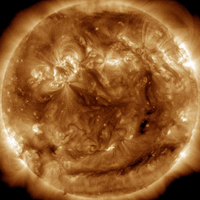
There are no significant coronal holes on the Earthside of the sun. Credit: SDO/AIA  Noctilucent Clouds Noctilucent Clouds
The summer season for northern noctilucent clouds has ended; the southern season will begin in November. Switch view: Europe, USA, Asia, Polar Updated Nov09  SPACE WEATHER
NOAA Forecasts | | Updated at: 2022 Nov 09 2200 UTC FLARE | 0-24 hr | 24-48 hr | CLASS M | 15 % | 15 % | CLASS X | 05 % | 05 % |  Geomagnetic Storms: Geomagnetic Storms:
Probabilities for significant disturbances in Earth's magnetic field are given for three activity levels: active, minor storm, severe storm Updated at: 2022 Nov 09 2200 UTC Mid-latitudes | 0-24 hr | 24-48 hr | ACTIVE | 25 % | 25 % | MINOR | 05 % | 05 % | SEVERE | 01 % | 01 % | High latitudes | 0-24 hr | 24-48 hr | ACTIVE | 15 % | 15 % | MINOR | 25 % | 30 % | SEVERE | 30 % | 30 % | | | |  | | | | | | | | | | | Never miss another geomagnetic storm. Sign up for Space Weather Alerts and you'll receive a text message when magnetic storms erupt. Aurora tour guides and professional astronomers use this service. You can, too! | | | ANOTHER COMET IS FALLING TOWARD THE SUN: It's happening again. A bright comet is falling into the sun today, Nov. 9th, following two earlier sundivers on Nov. 6th and 7th. These are Kreutz comets, fragments from the breakup of a larger comet centuries ago. They fall into the sun often, although so many bright ones in such a short period of time is unusual. Solar flare alerts: SMS Text URANUS AND THE OZONE FRINGE: During yesterday's lunar eclipse, most observers saw the Moon turn red. John Stetson of Sebago Lake, Maine, saw another color, too. "Blue! It's my favorite part of a lunar eclipse," says Stetson, who captured the phenomenon in this photo: 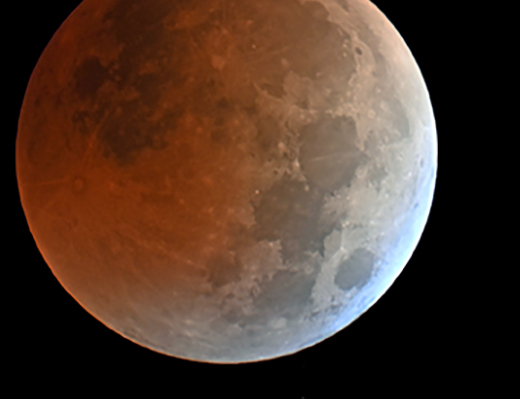
The blue is real. It's a sign of ozone. The core of Earth's shadow is red because it is filled with sunlight scattered by aerosols in the atmosphere. Sunsets are red for the same reason. However, the edge of Earth's shadow is blue. It contains light that has passed through the upper stratosphere where ozone absorbs red light and actually makes the passing light ray bluer. This is the origin of the "ozone fringe." Other observers saw it, too. That's not the only blue thing astronomers saw during the eclipse. Uranus made an appearance, too. The 7th planet from the sun is blue, and its azure disk popped out from behind the Moon during the eclipse. Bum-Suk Yeom sends this picture from Iksan, South Korea: 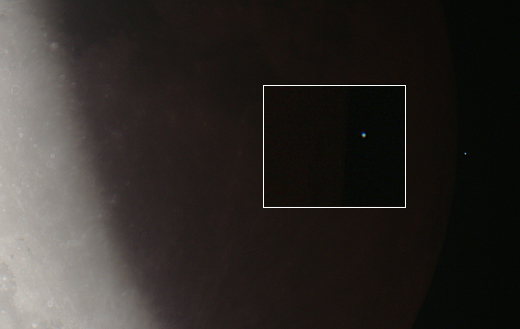
"I used a 150 mm refractor to catch Uranus emerging from the shadowed edge of the Moon," says Yeom. Ths was the end of a lunar occultation of Uranus visible from parts of North America and Asia. Normally, the faint planet would be hard to see near the edge of a full Moon, but Earth's shadow darkened the lunar disk enough for easy visibility. more images of Uranus: from Philip Bradbury at The Bund, Shanghai; from Dr. Ski of Valencia, Negros Oriental, Philippines; from Masayuki Nakamura of Otawara, Japan; from Shahrin Ahmad of Semporna, Sabah, Malaysia; from M. Shiraishi of Kumagaya-shi, Saitama, Japan; Got a picture of the eclipse? Submit it here! Realtime Space Weather Photo Gallery
Free: Spaceweather.com Newsletter STERLING SILVER HUMMINGBIRD PENDANT: This hummingbird has touched space. On Sept. 22, 2022, the students of Earth to Sky Calculus launched the sterling silver pendant to the stratosphere onboard a cosmic ray research balloon, more than 117,710 feet high: 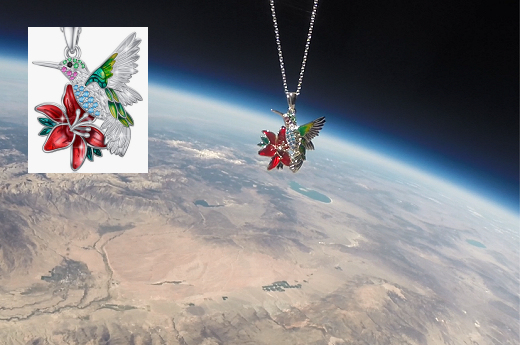
You can have it for $149.95. The students are selling hummingbird pendants to pay the helium bill for their cosmic ray ballooning program. Each one comes with a greeting card showing the bird and red lily in flight, and telling the story of their trip to the stratosphere and back again. Far Out Gifts: Earth to Sky Store
All sales support hands-on STEM education
Realtime Aurora Photo Gallery
Free: Spaceweather.com Newsletter Every night, a network of NASA all-sky cameras scans the skies above the United States for meteoritic fireballs. Automated software maintained by NASA's Meteoroid Environment Office calculates their orbits, velocity, penetration depth in Earth's atmosphere and many other characteristics. Daily results are presented here on Spaceweather.com. On Nov 09, 2022, the network reported 38 fireballs.
(23 sporadics, 15 northern Taurids) 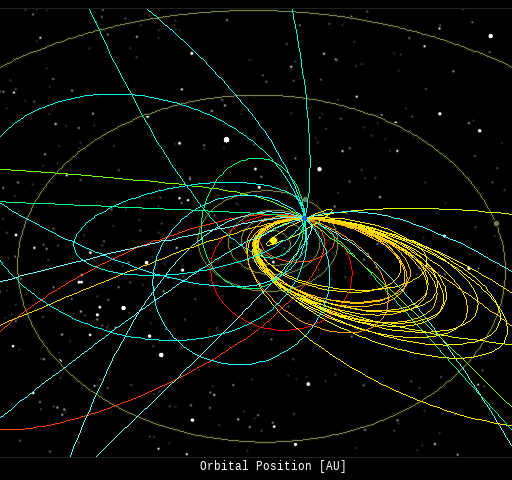 In this diagram of the inner solar system, all of the fireball orbits intersect at a single point--Earth. The orbits are color-coded by velocity, from slow (red) to fast (blue). [Larger image] [movies] Potentially Hazardous Asteroids ( PHAs) are space rocks larger than approximately 100m that can come closer to Earth than 0.05 AU. None of the known PHAs is on a collision course with our planet, although astronomers are finding new ones all the time. On November 9, 2022 there were 2314 potentially hazardous asteroids.
 | Recent & Upcoming Earth-asteroid encounters: | Asteroid | Date(UT) | Miss Distance | Velocity (km/s) | Diameter (m) | | 2022 UN5 | 2022-Nov-04 | 14.7 LD | 8.2 | 32 | | 2022 UB9 | 2022-Nov-04 | 16.4 LD | 6.5 | 18 | | 2022 UQ20 | 2022-Nov-04 | 3.1 LD | 8.3 | 12 | | 2022 VC | 2022-Nov-04 | 7.2 LD | 9.9 | 17 | | 2022 UL6 | 2022-Nov-04 | 17.6 LD | 4.4 | 39 | | 2022 UB16 | 2022-Nov-05 | 7.5 LD | 19.7 | 44 | | 2022 UK10 | 2022-Nov-05 | 15.4 LD | 11.8 | 27 | | 2022 UM21 | 2022-Nov-05 | 10.2 LD | 14.3 | 17 | | 2022 UM16 | 2022-Nov-05 | 11.8 LD | 15.8 | 69 | | 2022 UY14 | 2022-Nov-06 | 8.8 LD | 19.8 | 34 | | 2022 UC34 | 2022-Nov-06 | 1.7 LD | 10.9 | 7 | | 2022 UO6 | 2022-Nov-06 | 11.5 LD | 11.5 | 38 | | 2022 VA | 2022-Nov-06 | 8.2 LD | 12.3 | 25 | | 2022 UC22 | 2022-Nov-07 | 18.3 LD | 17.4 | 198 | | 2022 UN21 | 2022-Nov-07 | 8 LD | 11.1 | 18 | | 2022 US6 | 2022-Nov-07 | 9.7 LD | 7.2 | 19 | | 2022 UR21 | 2022-Nov-07 | 8.6 LD | 9.8 | 17 | | 2022 VY | 2022-Nov-08 | 3.1 LD | 10 | 10 | | 2022 UK5 | 2022-Nov-08 | 14.3 LD | 5.2 | 43 | | 2020 WD | 2022-Nov-08 | 3 LD | 6 | 8 | | 2022 UC5 | 2022-Nov-08 | 6.1 LD | 12.9 | 37 | | 2022 UV20 | 2022-Nov-09 | 7.7 LD | 8.4 | 20 | | 2019 XS | 2022-Nov-10 | 16.7 LD | 11.9 | 60 | | 2022 VP | 2022-Nov-11 | 8.1 LD | 5.1 | 19 | | 2022 UV14 | 2022-Nov-11 | 10.8 LD | 7.6 | 19 | | 2020 FC4 | 2022-Nov-12 | 19.3 LD | 13.3 | 78 | | 2022 VE | 2022-Nov-13 | 11.3 LD | 9.6 | 31 | | 2022 UH16 | 2022-Nov-14 | 14.8 LD | 9.8 | 23 | | 2022 UP2 | 2022-Nov-14 | 10.6 LD | 6 | 34 | | 2019 VL5 | 2022-Nov-15 | 8.5 LD | 8.1 | 24 | | 2022 UD28 | 2022-Nov-16 | 10.9 LD | 11.5 | 32 | | 2018 WH | 2022-Nov-16 | 2.5 LD | 7.7 | 4 | | 2022 US14 | 2022-Nov-18 | 8.5 LD | 8.2 | 39 | | 2022 VX | 2022-Nov-20 | 11.2 LD | 5.9 | 13 | | 2019 OR1 | 2022-Nov-21 | 18.1 LD | 13.4 | 246 | | 2005 LW3 | 2022-Nov-23 | 3 LD | 13.5 | 168 | | 2022 VQ | 2022-Nov-27 | 7.7 LD | 8.2 | 24 | | 2010 VQ | 2022-Dec-02 | 11.9 LD | 3.9 | 10 | | 2009 HV58 | 2022-Dec-02 | 12.3 LD | 28.8 | 427 | | 2022 UT8 | 2022-Dec-02 | 11.1 LD | 4.2 | 64 | | 2017 QL33 | 2022-Dec-03 | 16 LD | 6.9 | 195 | | 2019 XY | 2022-Dec-10 | 3.6 LD | 12.9 | 9 | | 2003 YS70 | 2022-Dec-13 | 10.4 LD | 4.1 | 5 | | 2019 XQ1 | 2022-Dec-13 | 14.5 LD | 9.8 | 30 | | 2018 XU3 | 2022-Dec-13 | 14.8 LD | 10.3 | 30 | | 2021 XS4 | 2022-Dec-14 | 14.5 LD | 9.7 | 23 | | 2015 RN35 | 2022-Dec-15 | 1.8 LD | 5.9 | 84 | | 2016 YE | 2022-Dec-18 | 18.6 LD | 4.8 | 23 | | 2014 HK129 | 2022-Dec-20 | 6.7 LD | 11.6 | 214 | | 2017 XQ60 | 2022-Dec-21 | 18.8 LD | 16 | 45 | | 2022 UD9 | 2022-Dec-22 | 4.6 LD | 10.3 | 153 | | 2022 RD2 | 2022-Dec-22 | 13.9 LD | 1.1 | 7 | | 2013 YA14 | 2022-Dec-25 | 2.7 LD | 10.5 | 68 | | 2022 TE14 | 2022-Dec-25 | 11.2 LD | 7 | 128 | | 2018 YK2 | 2022-Dec-26 | 15.8 LD | 15.1 | 98 | | 2010 XC15 | 2022-Dec-27 | 2 LD | 10.1 | 184 | | 2021 AE | 2022-Dec-28 | 16.5 LD | 15 | 23 | | 2021 NF | 2023-Jan-02 | 17.9 LD | 11.3 | 40 | | 2011 WR41 | 2023-Jan-03 | 15.8 LD | 8.9 | 34 | | 2019 AY3 | 2023-Jan-04 | 16.8 LD | 19.7 | 62 | Notes: LD means "Lunar Distance." 1 LD = 384,401 km, the distance between Earth and the Moon. 1 LD also equals 0.00256 AU. | | Cosmic Rays in the Atmosphere | SPACE WEATHER BALLOON DATA: Almost once a week, Spaceweather.com and the students of Earth to Sky Calculus fly space weather balloons to the stratosphere over California. These balloons are equipped with sensors that detect secondary cosmic rays, a form of radiation from space that can penetrate all the way down to Earth's surface. Our monitoring program has been underway without interruption for 7 years, resulting in a unique dataset of in situ atmospheric measurements. Latest results (July 2022): Atmospheric radiation is decreasing in 2022. Our latest measurements in July 2022 registered a 6-year low: 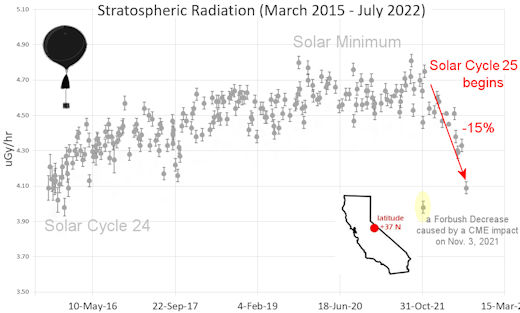
What's going on? Ironically, the radiation drop is caused by increasing solar activity. Solar Cycle 25 has roared to life faster than forecasters expected. The sun's strengthening and increasingly tangled magnetic field repels cosmic rays from deep space. In addition, solar coronal mass ejections (CMEs) sweep aside cosmic rays, causing sharp reductions called "Forbush Decreases." The two effects blend together to bring daily radiation levels down. .Who cares? Cosmic rays are a surprisingly "down to Earth" form of space weather. They can alter the chemistry of the atmosphere, trigger lightning, and penetrate commercial airplanes. According to a study from the Harvard T.H. Chan school of public health, crews of aircraft have higher rates of cancer than the general population. The researchers listed cosmic rays, irregular sleep habits, and chemical contaminants as leading risk factors. A number of controversial studies (#1, #2, #3, #4) go even further, linking cosmic rays with cardiac arrhythmias and sudden cardiac death. Technical notes: The radiation sensors onboard our helium balloons detect X-rays and gamma-rays in the energy range 10 keV to 20 MeV. These energies span the range of medical X-ray machines and airport security scanners. Data points in the graph labeled "Stratospheric Radiation" correspond to the peak of the Regener-Pfotzer maximum, which lies about 67,000 feet above central California. When cosmic rays crash into Earth's atmosphere, they produce a spray of secondary particles that is most intense at the entrance to the stratosphere. Physicists Eric Regener and Georg Pfotzer discovered the maximum using balloons in the 1930s and it is what we are measuring today. | | The official U.S. government space weather bureau | | | The first place to look for information about sundogs, pillars, rainbows and related phenomena. | | | Researchers call it a "Hubble for the sun." SDO is the most advanced solar observatory ever. | | | 3D views of the sun from NASA's Solar and Terrestrial Relations Observatory | | | Realtime and archival images of the Sun from SOHO. | | | information about sunspots based on the latest NOAA/USAF Active Region Summary | | | current counts of failed and deployed Starlink satellites from Jonathan's Space Page | | | Authoritative predictions of space junk and satellite re-entries | | | from the NOAA Space Environment Center | | | fun to read, but should be taken with a grain of salt! Forecasts looking ahead more than a few days are often wrong. | | | from the NOAA Space Environment Center | | | the underlying science of space weather |  | BestCSGOGambling is the best site for everything related to CSGO gambling on the web |  | To find reviews of new online casino sites in the UK try The Casino DB where there are hundreds of online casino reviews complete with bonuses and ratings. Alternatively, Online-Casinos.xyz is another massive directory of online casinos listing sites for the UK and Worldwide. Casinos that offer Rupees for bonuses are very generous to Indian players. Find the best online casinos in India at AllCasinos.in Looking for a new online casino? Try Casimpo the new site dedicated to making online casino simple, or check out the new Avenger Slots Casino and Ace Online Casino with over 500 online slots and casino games. |  | One of the most popular casino games is the Book Of Dead Slot based on ancient Egyptian text, you can find all the casinos with spins at bookofdeadslotsites.com. |  | When looking for casinos to play online when the weather is bad, you can try casino online trucchi for Italian games. If you are not from Finland you can try the Swedish page Svenska casino online to find suitable games, check out svenskacasinoonline.net. Always check your local laws before playing with real money. |  | Looking for sports betting companies not registered on GamStop? CasinoGap has presented a list of sites not on GamStop available for UK players. Check and bet online! Would you like to bet at sites not using GamStop? Look at a list of NonStopCasino sites for online betting that aren't on GamStop. Top-rated bookmakers ever! | | | These links help Spaceweather.com stay online. Thank you to our supporters! | | | | | | | | |  | |  |   | ©2021 Spaceweather.com. All rights reserved. This site is penned daily by Dr. Tony Phillips. | |

